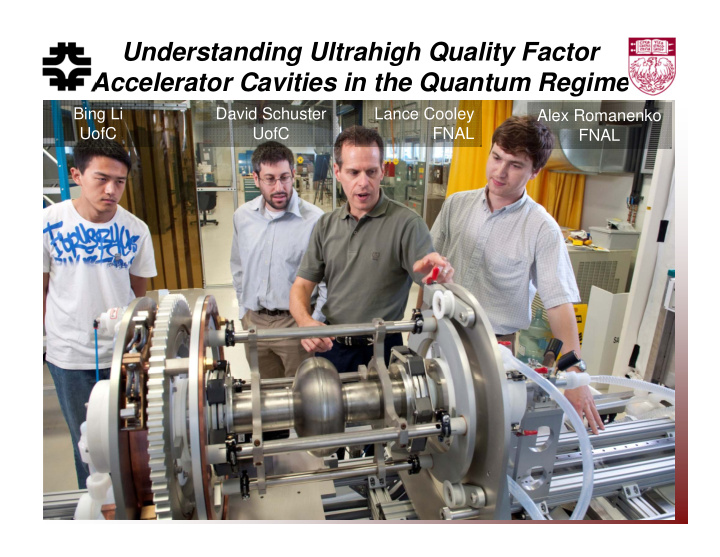



Understanding Ultrahigh Quality Factor Accelerator Cavities in the Quantum Regime Bing Li David Schuster Lance Cooley Alex Romanenko UofC UofC FNAL FNAL
State of the art for SC qubits From this week’s APS Physics Viewpoint /PRL: • Best T 2 ~ 50 µsec • Q 2 ~ 400,000 Why are we excited? • A typical accelerator cavity has Q > 10 10 • This corresponds to T 2 > 1 second! H. Paik, D. I. Schuster, et. al. PRL 107, 240501 (2011)
First results (power dependence) Resonator Internal Quality 500,000 – 1M 50,000 – 150,000
Typical Fermilab cavity performance Q 0 is limited to 10 9 by • excitation of normal electrons at 2 K • We expect residual resistance of ~10 n based on known results for this process 10 9 Rs 2K 1/T
Quantum Computer vs. Accelerator Cavities • QC cavities optimized for coupling to single photon , limited by loss of single photon • Accelerator cavities optimized for highest accelerating field , limited by breakdown at maximum power • Both want high Q but everything else is different Property QC Accelerator Comparison Quality Factor Frequency 4-10 GHz 1-10 GHz 1 10 -18 W Input power 1 W Temperature 0.01 K 2K Mode volume E field strength
Millikelvin resonator characterization system • Measure samples down to 13 mK • Measure with powers down to <1 aW
Now possible to couple qubits to 3D cavities Cu matchbox Cavity cavity 1 cm Al Cavity (indium sealed) Have tried, Cu, Nb, Al, and “solder dipped” All SC ones achieved Q~1M H. Paik, D. I. Schuster, et. al. PRL 107, 240501 (2011)
First measurements of a Fermilab Cavity at T << 1 K!! • Fermilab cannot test below ~1.5 K – This is uncharted territory! • Q = 40,000,000 – Higher than any QC qubit / resonator! – … but why isn’t this 10 10 ? • Reasonable frequency vs temp • Strange Q(T) dependence • For early data, cavity temperature was not equal to fridge temperature
Next steps • Try to understand why Q appears to be lower at UofC – Improve measurements of the Fermilab cavities • Modify coupling of antenna • Bring in expertise of cavity test group at Fermilab • Phase-locked loop scheme should be used for high Q • Add magnetic shielding • Then: – Design cavity compatible with SC qubit • Possibly fabricate it at Fermilab – Dynamically tunable Q – Attempt to miniaturize cavities
Recommend
More recommend